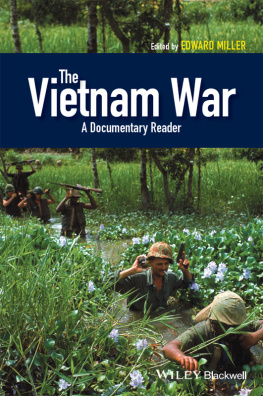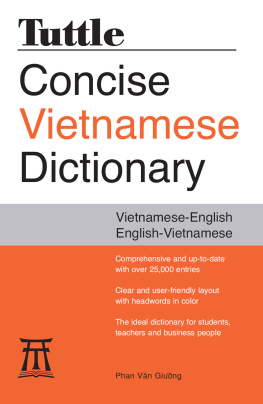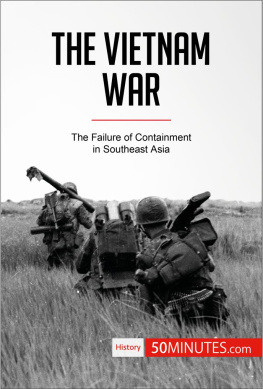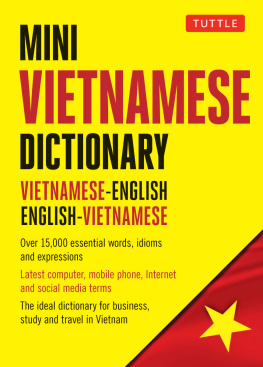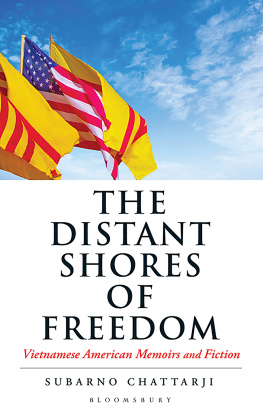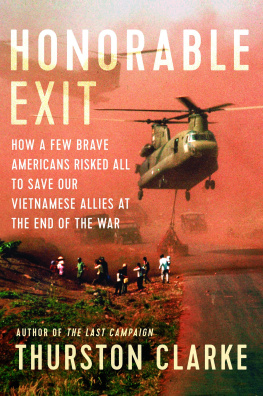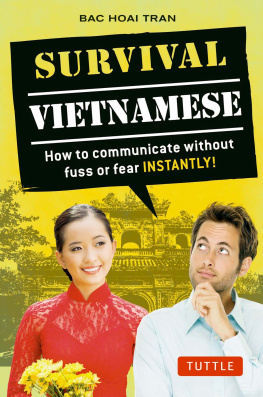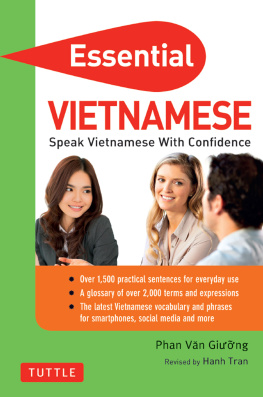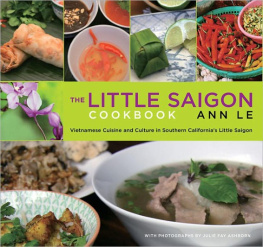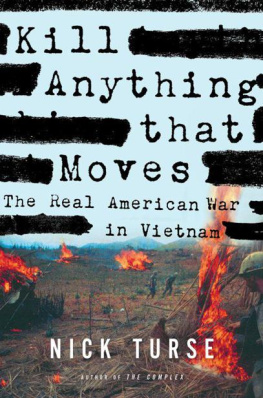A VIETNAM WAR READER
2010
THE UNIVERSITY OF NORTH CAROLINA PRESS
All rights reserved
Designed by Kimberly Bryant Set in Arnhem, The Sans, and Coldharbour Gothic types by Rebecca Evans
Manufactured in the United States of America
The paper in this book meets the guidelines for permanence and durability of the Committee on Production Guidelines for Book Longevity of the Council on Library Resources.
The University of North Carolina Press has been a member of the Green Press Initiative since 2003.
Library of Congress Cataloging-in-Publication Data
A Vietnam War reader: a documentary history
from American and Vietnamese perspectives /
edited by Michael H. Hunt. 1st ed.
p. cm.
Includes bibliographical references and index.
ISBN 978-0-8078-3350-6 (cloth: alk. paper)
ISBN 978-0-8078-5991-9 (pbk: alk. paper)
1. Vietnam War, 19611975 Sources.
I. Hunt, Michael H.
DS 557.4.V 626 2010
959.7043 dc22 2009031224
The map of Vietnam is from The World Transformed: 1945 to the Present by Michael H. Hunt. Copyright 2004 by Bedford/St. Martins. Used with permission.
cloth 14 13 12 11 10 5 4 3 2 1
paper 14 13 12 11 10 5 4 3 2 1
To the students
in my Vietnam War course at
Colgate University, UNCChapel Hill,
and Williams College (19782008),
whose enthusiasm for these documents
fed my own.
Contents
Preface
The prolonged and bloody conflict widely known as the Vietnam War touched the lives of many people in many different social and political situations. There is thus not one or two perspectives on it but a great variety. Incorporating that variety is an interpretively urgent goal yet one of the most difficult tasks faced by anyone confronting that conflict.
In shaping this volume, I have made some practical editorial decisions:
Limiting the documents that appear here to a carefully selected representative sample from a large and still growing body of evidence. In the interest of providing diverse points of view, I have done considerable excerpting, sometimes cutting sharply.
Focusing tightly on Americans and Vietnamese at war and thus excluded materials that deal with the allies that Hanoi and Washington recruited, including Soviet, South Korean, Australian, Philippine, and Thai. Also missing are the Cambodians and Laotians, who felt the side effects of the struggle in Vietnam with special intensity. So too have I left out the accounts of young people worldwide in places as far flung as Paris, Tokyo, and Mexico City who responded to the war with a passion that defines the time.
Giving Vietnamese and Americans equal time. In what follows, American policy makers and soldiers share the spotlight with the Vietnamese, who were their main antagonist and whose land took the main pounding. Thus the seven chapters here go well beyond the dates normally associated with the U.S. war (19651973) and include not just the Communist leaders defying Washington but also early nationalists, ordinary activists and soldiers, peasants, and those on the Saigon side. In the interest of balance, I have included a fair sample of official Vietnamese documents (internal and public) even though some are available only in rough translations and are couched in what may seem formulaic Marxist terminology. My interest in balance has also led to a decision in treating the societal dimensions of war to give Vietnamese a heavy emphasis in chapter1, offset by devoting all of chapter 6 to developments within the United States.
Devising a format that is meant to be engaging and user-friendly. The overall arrangement of the documents is chronological so that Vietnamese and American views on particular issues and during particular phases of the war are again and again juxtaposed, thus inviting attention to the interplay between the actors and comparisons among them. I have provided only the background information essential to moving through materials sprawling across some seven decades and dealing with topics as exotic as Vietnamese nationalism and communism and the contested countryside. My introduction sketches the misconceptions surrounding the war and the various stages in its evolution. Accompanying that introduction are a guide to abbreviations, a detailed chronology, and a map of Vietnam. Each of the seven documentary chapters opens with a brief overview of the main themes and questions raised by the documents to follow and includes background information for each section and each document within each section. A brief concluding section at the end of the final chapter gives readers a chance to reflect on what they have learned and offers some general questions to facilitate that task. Throughout I have tried to keep my own views on a leash so that readers will feel free to grapple on their own with the important questions still surrounding the Vietnam War.
Editing of the source texts in a way that follows a consistent set of guidelines and that keeps editorial clarifications and corrections to a minimum. Spellings and italics follow the source texts. In changing capitalization and inserting ellipses, I have followed the rigorous method of The Chicago Manual of Style.
The main goal of this collection will have been realized if readers find they can critically engage the evidence gathered here and, from that evidence, formulate their own, historically grounded sense of what the Vietnam War was about.
It is a pleasure to acknowledge those who have helped make this volume possible. Once more I owe thanks to the University of North Carolina Press: foremost my editor, Chuck Grench; his assistant, Katy OBrien; Paul Betz, who brought order to the manuscript and the production process; Vicky Wells, my patient guide on copyright issues; Anna Laura Bennett, who provided thoughtful and meticulous copyediting; and Kim Bryant for a design done with flair and care. I received helpful advice in the early stages of this project from Pierre Asselin and Allan M. Winkler. Christopher Goscha as well as Winkler provided incisive comments on the first full draft. At a pivotal point Rosalie Genova read the manuscript with a keen editorial eye and sharp pedagogical sense, while Peter Agren made sensibly ruthless suggestions on tightening the documents. Will West did yeoman service checking the accuracy of the documents excerpted here. Finally, my thanks to Jon Huibregtse for permission to draw in the introduction on my Studying the Vietnam War: Between an Implacable Force and an Immovable Object, New England Journal of History 54 (Spring 1998): 4561.
Introduction
The Vietnam War: From Myth to History
For most Americans today, the history of the Vietnam War is like a play that unfolds in ways quite different from the audiences preconceptions. Ticket holders take their seats expecting a drama about American soldiers. But once the curtain goes up, there are some surprises the Vietnamese characters dominate the stage at the outset, the American characters arrive late (soldiers among the last), the play proves far longer than anticipated, and the plotline takes some unfamiliar twists. This collection of documents snippets from a real drama should also shatter some expectations that readers carry in their heads. The materials gathered here suggest that the Vietnam War was not mainly about U.S. soldiers and that it spanned a good deal more than the decade of direct U.S. combat.
MISUNDERSTANDING AN UNPOPULAR WAR
Many Americans feel instinctively that they know the Vietnam conflict in large measure because of popular myths and misconceptions incorporated and propagated, if not actually created, through the movies and other widely consumed U.S. media. Hollywood, with its trademark capacity for neat packaging and simple messages, tackled the war in the late 1970s, and in a steady output over the following decades, it became the single most important source for public memory. One movie critic commented wryly, Since 1977, Hollywood has been succeeding where Washington consistently failed: namely, in selling Vietnam to the American public.wild Indians. Seldom do the serious political issues raised by the war come into view, and the Vietnamese rarely figure as anything more than bit players in an American drama.


